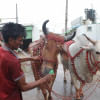Amid Dhaka's chaos, a bruised stray puppy limps across the road, eyes filled with terror. Nearby, teenagers chuckle as one throws a stone, sending the puppy yelping away. Such cruelty is common, yet rarely makes headlines. From street dogs to cats, countless animals suffer abuse. But what drives people to harm these defenceless creatures for no apparent reason? The answers lie in human psychology, shaped by behaviour, upbringing, and societal norms.
According to Professor Dr Helal Uddin Ahmed, from the Department of Child, Adolescent, and Family Psychiatry at the National Institute of Mental Health, the reasons can be divided into three categories: cognitive learning, societal learning, and mental disorders.

What we see, we do
Children learn behaviours from their surroundings. If a child grows up in a household where animals are treated with cruelty, they may imitate this behaviour, believing it to be normal.
Dr Ahmed explains, "A child's perception of right and wrong is shaped by their immediate environment. If they repeatedly witness cruelty towards animals in their family or community, they are likely to accept it as normal behaviour. Empathy is also vital — if a child is not taught to understand and care for the emotions of others, including animals, they will not develop compassion towards them."
In many Bangladeshi households, stray dogs and cats are treated as nuisances. Some parents even encourage their children to chase them away with sticks or stones. As a result, these children grow up without an understanding of animal welfare, and cruelty becomes second nature.
Conforming to norms
Even those who are naturally empathetic towards animals may suppress their compassion to fit into societal expectations. If a society collectively mistreats animals, individuals may feel pressured to do the same.
"Even an empathetic individual may struggle to act according to their values if societal norms dictate otherwise. If cruelty towards animals is normalised in a community, individuals may participate in it merely to conform or avoid standing out," Dr Ahmed states.
A striking example is the mass culling of street dogs in Dhaka. Many municipalities use poisoning or inhumane methods to reduce the stray population. When the government normalises cruelty, it sends a message to citizens that harming animals is acceptable.
Mental disorders and trauma
Some individuals harm animals due to deeper psychological issues. Mental disorders such as conduct disorder (in children), borderline personality disorder, and schizophrenia are often linked to acts of cruelty.
Dr Ahmed elaborates: "Childhood trauma can significantly shape a person's behaviour. A child who has suffered violence or neglect often struggles to process their emotions and may project that violence onto others, including animals."
Studies show that many individuals who commit violent crimes against humans first exhibited cruelty towards animals. This connection highlights the importance of early intervention in preventing not only animal abuse but, also future violence towards people.
How can we prevent animal cruelty?
The first step in preventing cruelty is fostering compassion at home.
"Kindness towards animals begins at home. Parents must set an example by treating animals with respect and encouraging children to develop empathy through positive interactions with pets and strays," Dr Ahmed stresses.
Educational institutions can play a vital role in creating awareness about animal welfare. Schools should introduce lessons on empathy and responsible pet ownership. Children should also be taught about the connection between cruelty to animals and broader societal violence.
When it comes to shaping public perception, Bangladesh's entertainment industry and social media influencers have a major role to play and their positive storytelling about rescued animals or kind behaviour towards strays can shift attitudes over time.
"Public figures — whether actors, politicians, or business leaders — have an enormous influence on societal attitudes. If they actively promote kindness towards animals, people are likely to follow," Dr Ahmed emphasises.
It is important to note that while Bangladesh has laws against animal cruelty, most of them are outdated and rarely enforced. Stronger legal actions, coupled with community-based reporting mechanisms can deter individuals from harming animals without consequence.
Above all, no being — human or animal — deserves to suffer for someone else's frustration, amusement, or ignorance. As a society, we must take a stand against animal cruelty and ensure that future generations grow up with compassion rather than indifference.








Comments